Crested Geckos are interesting and amazing pets – even for first time reptile owners.
On top of being (relatively) easy to keep, Crested Geckos also don’t require an overly elaborate setup. In fact, setting up a Crested Gecko habitat is actually very simple.
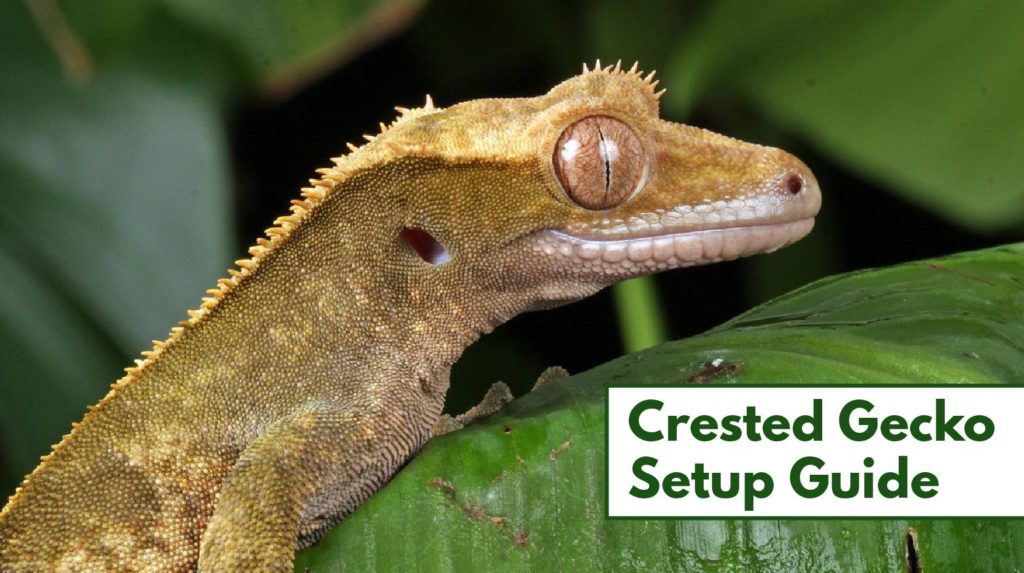
In this complete guide, we go through everything you need to know about putting together the perfect Crested Gecko setup.
Sit back, relax, and let us teach you everything there is to learn about these amazing creatures!
Quick Navigation
Step 1: Choosing a Crested Gecko Habitat
The first step in putting together a suitable Crested Gecko setup is choosing the right habitat. There are two main routes you can go with here – you can buy a habitat made specifically for reptiles (recommended), or you can go the DIY route. First, though, lets talk about habitat sizing.
Sizing
Crested Geckos are natural climbers. When it comes to terrarium sizing, height is a lot more important than width (since they love to climb).
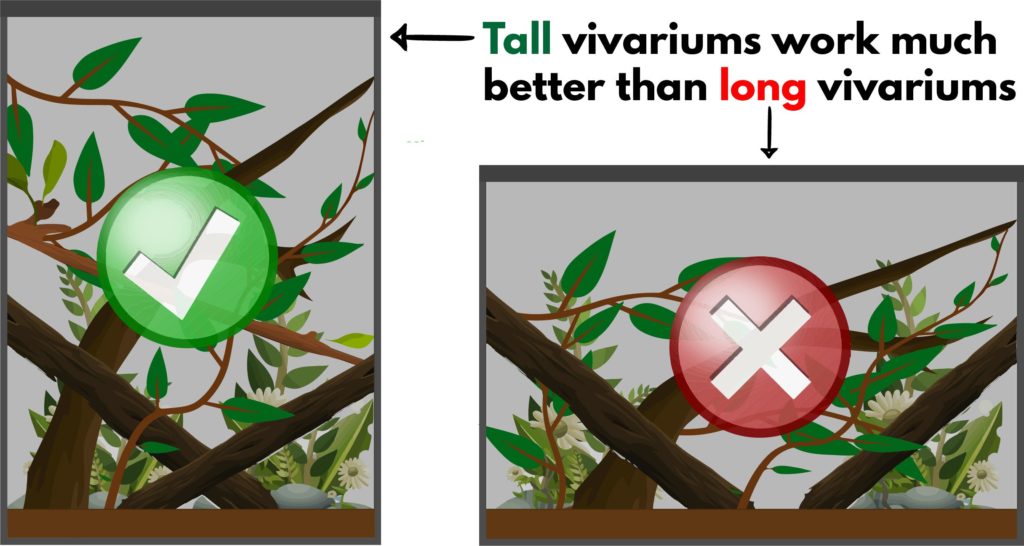
While I’ve found that a 18″ x 18″ x 24″ enclosure works best, a lot of people out there claim 12″ x 12″ x 18″ terrariums are sufficient.
That being said, I highly recommend going with the larger of the two – your Crested Gecko will be much happier in the long run and you can even add a second gecko later on if you choose to do so.
Recommended Crested Gecko Habitat – Exo Terra Terrarium
- Glass terrarium for reptiles or amphibians
- Patented front window ventilation
- Raised bottom frame in order to fit a substrate heater and has a waterproof bottom
If you don’t mind spending a little extra money, picking up a Exo Terra All-Glass Terrarium will probably save you a lot of time and effort in the long run. Exo Terra has a great name in the reptile hobby and their terrariums are top-notch.
As we discussed above, the 18″ x 18″ x 24″ Exo Terra setup is perfect for an adult Crested Gecko – it will even allow you to house a second one later if you decide you want a pair.
One thing I love about Exo Terra’s terrariums is the front facing panels. These ventilated doors make is super easy to set up the habitat (as opposed to reaching through the top of the tank) and help control humidity levels.
In addition, the realistic rock background is a huge upgrade compared to other backgrounds on the market and contributes to a nice, natural look.
All in all, Exo Terra Terrariums are really effective and will probably save you tons of time/effort (and maybe even money) in the long run.
The DIY Option
If you don’t want to buy a “pre-made” reptile habitat, there are also a few good DIY options out there.
One popular choice among Crested Gecko owners is a simple plastic tub. Although plastic tubs have their upsides (very cheap, easy to clean), they also have a few obvious downsides.
First of all, they’re obviously not exactly the most attractive choice. If you’re planning on setting up the enclose in your living room or bedroom, you probably don’t want a big plastic tub lying around. In addition, the plastic tub option doesn’t really allow you to view your Crested Gecko.
Another popular DIY habitat choice is using a 20 gallon long aquarium (or even larger) and flipping it on its side. By flipping the tank, you get that ever important height that Crested Geckos love. With this route, you’re obviously going to need some sort of top so that the front side of the habitat isn’t completely open.
Although these DIY options can be effective and cheap, they’re not going to provide the same beauty and enjoyment as a dedicated reptile setup. If you’re a first time Crested Gecko owner, we recommend going with an Exo Terra Terrarium.
Step 2: Substrate
Your substrate choice largely comes down to your Crested Gecko’s age and size – but why?
Because younger Crested Geckos are usually at a much higher risk of impaction.
For those that don’t know, impaction is an intestinal block often caused by eating substrate. It is a very serious issue and can often be fatal.
Adult Crested Geckos are usually good enough at avoiding substrate while eating, so it’s not as big of an issue. Here are our recommendations based on you Crested Geckos size/weight:
For Crested Geckos < 15 grams…
For Crested Geckos less that 10-15 grams (generally 6-8 months, though growth rates vary) I like to stick to a simple paper towel substrate. I know, I know…it sounds horrible. Paper towels aren’t exactly the most attractive substrate, but they have tons of benefits. Here are a few:
- Hold moisture well: Paper towels hold moisture well and help stabilize the humidity of your terrarium.
- Extremely cheap: Substrate can get expensive. Paper towels, though, cost you virtually nothing.
- Easy to clean/replace: Using paper towels as a substrate makes cleaning a breeze. Simply scoop up the paper towel with whatever waste and throw in a new sheet – easy, quick, and cheap.
- No risk of impaction: As long as you don’t rip the paper towel up into a million pieces (why would you?), there is virtually no risk of it getting mixed up with their food. No more worrying about impaction!
For Crested Geckos > 15 grams…
A lot of Crested Gecko owners like to switch their geckos over to a natural substrate once they begin to mature. Since they typically have much stronger digestive systems at this point, the risk of impaction isn’t nearly as high.
Our substrate of choice for mature Crested Geckos is Zoo Med Eco Earth. This shredded coconut fiber substrate is 100% natural/eco-friendly and is one of the most widely-used Crested Gecko substrates on the market.
- Ideal for naturalistic terrarium type set-ups incorporating reptiles, amphibians, or invertebrates
- Use it damp for tropical species as it naturally absorbs and breaks down odor and waste products
- Ideal substrate for all types of reptiles, amphibians, small animals or insects
Keep in mind, there is always a small risk of impaction when using a loose substrate such as Eco Earth. That said, tons of people use it with their Crested Geckos (even babies) for years with zero issues.
I recommend going with paper towels until your Crested Gecko matures a bit, then switching over to Eco Earth.
Step 3: Filling the Tank
Filling your Crested Gecko’s vivarium with suitable plants, logs, and decorations is extremely important for their long term happiness and comfortability (and even health!). Here are a few things you will need to populate the enclosure:
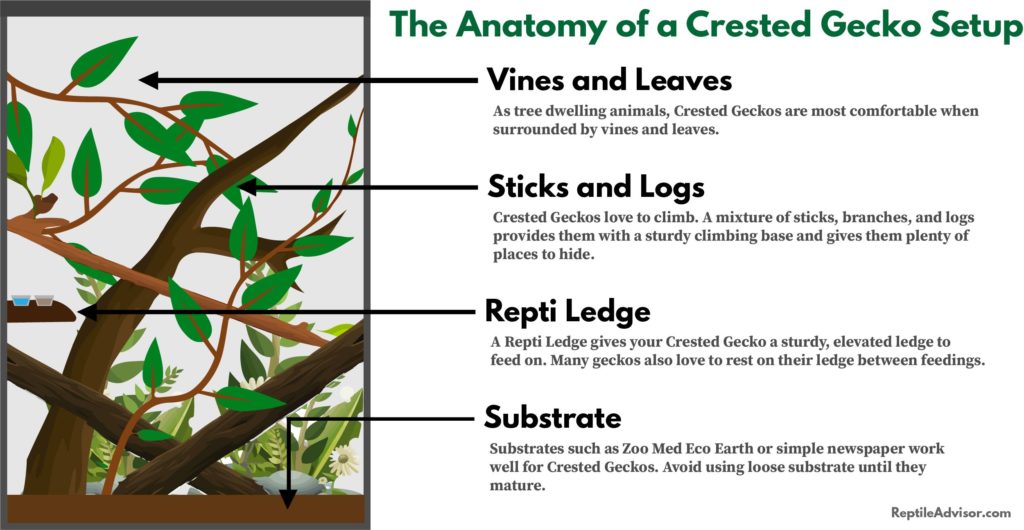
Branches/Logs
Since Crested Geckos are natural tree dwelling animals, they really appreciate having something to climb on – hence the importance for sticks and branches. When it comes to Crested Geckos, the more decor the better. Don’t be afraid to pack your terrarium full – they LOVE it!
Here are a few types of woods that I recommend for Crested Gecko terrariums:
- Zoo Med Cork Bark: Cork bark is probably the best type of wood for Crested Gecko terrariums because it is naturally mold resistant. It a humid environment, mold resistance is a huge plus.
- Grapewood Branches: Grapewood branches are one of my personal favorite. They come in some awesome shapes and designs and can really bring a terrarium to life. They tend to be on the pricier side, but are definitely worth the extra cost.
- Zoo Med Mopani Wood: Mopani wood is most commonly used in aquariums, but it also works well in Crested Gecko terrariums. It isn’t quite as mold resistant as cork bark, but does pretty well in my opinion. In addition, it is also very affordable.
A lot of people elect to simply collect wood from a forest or their backyard. Surprisingly, this is actually 100% safe – as long as you do it correctly. Here are some types of wood that are safe for Crested Geckos:
- Mopani
- Birch
- Maple
- Grape
- Oak
If you are going to collect wood yourself, you will have to treat it to remove any harmful microorganism – this part is very important. First, scrub the wood with a 5% diluted bleach mixture. After the scrub is complete, preheat your over to 300°F and bake the wood for 30 minutes. This should sterilize the wood and make it completely safe for your Crested Geckos.
Planting Your Vivarium
Branches aren’t the only vital decor in your Crested Gecko setup – plants and vines are also equally as important. After all, Crested Geckos naturally spend a majority of their time in trees.
When it comes to plants, I like to keep everything 100% artificial. Live plants can be a ton of work and make the setup much harder to keep up with.
The first thing I like to place in the terrarium (after the wood) is some sort of vine. Vines can be draped across the terrarium and tend to be a Crested Gecko favorite. We recommend the Exo Terra Jungle Vine.
As far as plants go, you want to look for something with suction cups to make the setup process as easy as possible. Flunker’s Repta Vines is a personal favorite and will work perfectly for any Crested Gecko setup. One package should be more than enough (nearly 6 feet in length).
The Repti-Ledge
Every proper Crested Gecko habitat needs a feeding ledge. These natural-looking ledges attach to the side of your terrarium via magnets and house your gecko’s food and water dishes.
A feeding ledge is an important addition to your habitat because Crested Geckos prefer to eat at elevated heights. In fact, some geckos will completely refuse food placed on the ground. By placing the food bowl higher up in the terrarium, your Crested Gecko will feel much more comfortable eating.
Just don’t be surprised if your Repti Ledge becomes your Crested Gecko’s new favorite hangout spot!
Step 4: Lighting, Temperature & Humidity
Crested Geckos are pretty simple when it comes to their lighting and heating requirements.
Here are the basics that you should be aware of:
Temperature Requirements
Crested Geckos do best in temperates between 70 and 80°F. As long as your house temperature stays within the range, your geckos should be happy and healthy.
For most Crested Gecko owners, this temperature range means that extra heating devices usually aren’t necessary.
If the temperature in your house falls into the low 60’s at night (for example, in winter), invest in a Ceramic Heat Emitter. Make sure your heater doesn’t bump the temperature up too high – Crested Geckos don’t do well in temperatures above 85°F.
Quick Tip: The ambient temperature in your tank should be between 70 and 80°F. NEVER let your terrarium exceed 85°F.
Crested Gecko Lighting
Unlike some other reptiles (looking at you bearded dragons…), Crested Geckos don’t have super specific lighting requirements.
As primarily nocturnal animals, Crested Geckos don’t really require UVB lighting – this is somewhat debated among hobbyists, but the general consensus is that UVB bulbs aren’t a necessity.
That said, supplementing their diet with calcium is necessary to avoid Metabolic Bone Disease (calcium deficiency), especially if you aren’t using any sort of UVB light.
Product Recommendation: We recommend supplementing your Gecko’s diet with Repashy Superfood to ensure that all vitamin and mineral needs are being met.
As far as maintaining a day/night cycle, the light in your house should be more than sufficient. If you really want some sort of viewing light, the Exo Terra Day/Night LED is a good option.
Humidity
Controlling the humidity of your vivarium is a vital part of caring for your Crested Gecko. In general, Cresties prefer relatively high humidity – after all, they mostly inhabit rainforests in the wild.
To accurately measure the humitidy in your Crested Gecko enclosure, I recommend picking up a digital hygrometer. Stay away from the dial analog versions, as they tend to be pretty inaccurate.
To increase the humidity in your terrarium, lightly mist the entire tank with purified water via spray bottle (tap water should not be used). I like to mist twice per day – one light mist in the morning and a heavy mist at night.
As a rough rule, you want to mist to 80% humidity and then it fall to down to 50% throughout the day. Once it hits the mid 50’s, mist again. It’s important that your terrarium doesn’t stay at 80% humidity all day every day – Crested Geckos need a bit of fluctuation.
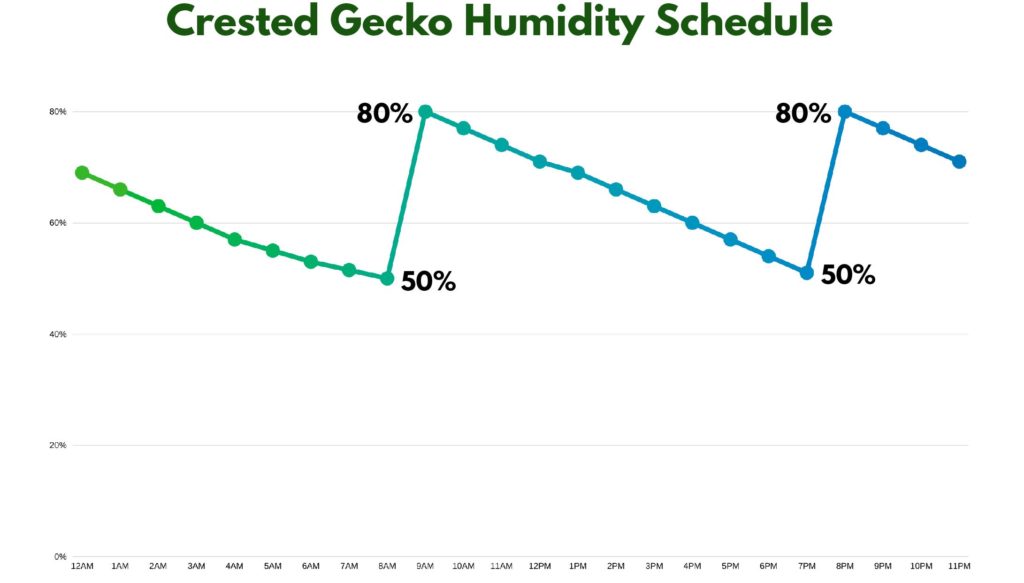
Use this humidity schedule as an example. Notice how humidity spikes at 8AM and 7PM – these are the daily mistings.
Humidity slowly falls throughout the day to 50% or so, at which time we mist again. Once again, just make sure there is some sort of variation in humidity – it shouldn’t be at 80% all throughout the day.
This is just an example, so feel free to adjust the times based on your schedule.
Step 5: Crested Gecko Care
This part should probably have its own separate article. Until then, here is the quick run down regarding Crested Gecko care:
Diet and Hydration
Crested Geckos are one of the easiest reptiles to feed – this is largely due to the huge advancements in commercially prepared gecko foods.
I know, I know…”commercially prepared” food doesn’t sound very natural. In reality, pre-made mixes such as Pangea Gecko Fruit Mix and Repashy’s Gecko Diet are perfect all-in-one diets that give your Crested Gecko absolutely everything they need (and have been tried and tested over many many years).
I highly recommend picking up one of these mixes rather than try to feed your gecko your own mixture of fruit, insects, and greens.
Feeding should take place every other day (3-4 times per week). For the occasional treat, feed your Crested Gecko live crickets dusted with a calcium supplement. Crickets shouldn’t be fed too often (2-3 times a month).
As for keeping your gecko hydrated, always keep a bowl of purified water in the terrarium (even if your gecko doesn’t like to drink from it). Most Crested Geckos prefer to get their water by licking moisture from leaves, which is another reason why misting is so important.
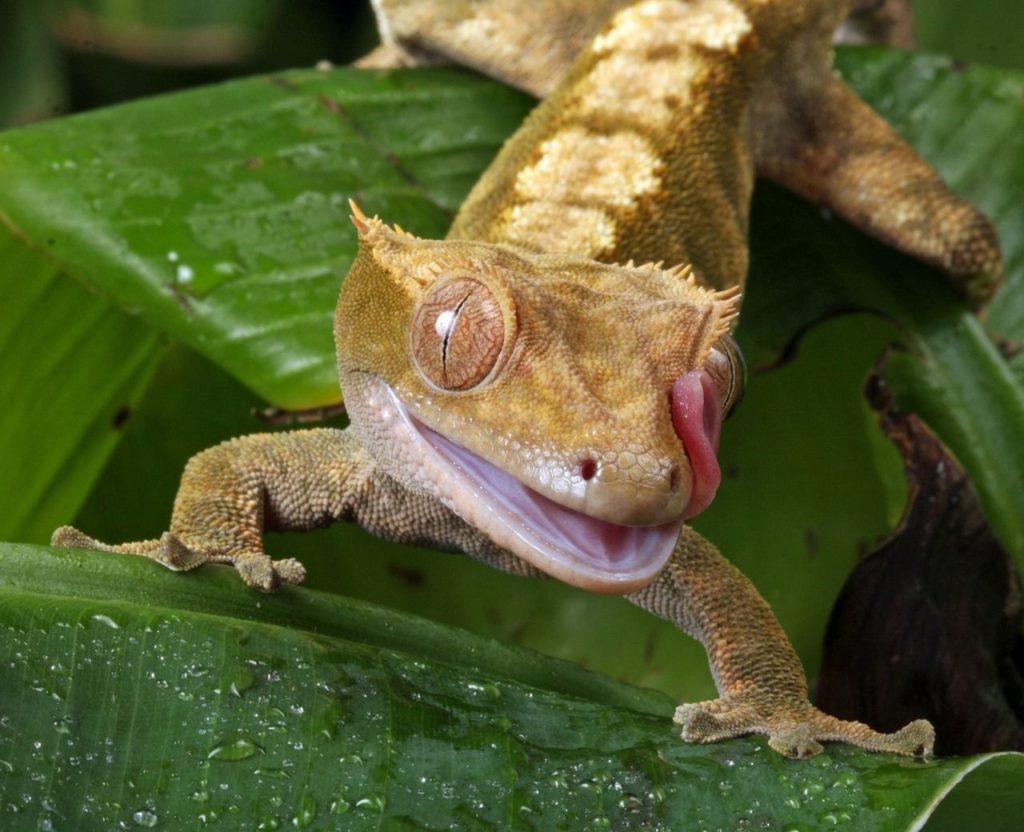
Handling Tips
Crested Geckos are one of the easiest lizards to handle – they are rarely aggressive and generally pretty calm. Here are a few tips for handling your gecko:
- When picking up your gecko, don’t just reach in and grab it from above. Instead, put your hand under its chin and let it crawl onto your hand. This lets your gecko know that you’re not a threat.
- Sit close to the ground when handling your gecko. Since they are natural jumpers, you don’t want your Crested Gecko tumbling from too high.
- Don’t squeeze your gecko – they are fragile animals and injure easily.
- Move your hands slowly and carefully – fast movements may seem threatening to your gecko.
As a general rule of thumb, never chase your Crested Gecko around the tank in an attempt to catch it. If your gecko doesn’t want to climb onto your hand, simply try again in a few hours. Properly handling a Crested Gecko is all about establishing trust.
Signs of a Healthy Gecko
A healthy Crested Gecko should be active, alert, and willing to interact with humans. Here are a few of the most common things to look for in regards to gecko health:
- Activity – Although Crested Gecko’s are nocturnal, they shouldn’t be hiding in the corner or sleeping 24/7. A healthy gecko will explore its tank and show interest in plants, people, and insects.
- A strong appetite – A healthy gecko should feed regularly. They aren’t the most ferocious eaters and may only eat a small amount each day, they they should be eating regularly nonetheless.
- Clear eyes and healthy skin – The eyes of your Crested Gecko should never be cloudy. Check their skin regularly for cuts, scrapes, or bruises.
- A clear nose and vent – A healthy gecko will rarely show discharge in their eyes, nose, or vent.
Most Crested Geckos will lose their tail by adulthood. This can happen for a variety of reasons – excessive handling, a loud noise (such as thunder or passing airplanes), or even no apparent reason at all.
Once a Crested Gecko drops its tail, it will not grow back. This does not mean you are a bad owner or did anything wrong.
Things To Look Out For
- Lack of appetite/weight loss – These are never good signs and should be addressed right away. A lack of appetite could signal that your gecko has an impaction, which should be addressed by a vet.
- Paralysis – Back leg paralysis is a common symptom of impaction – once again, if you notice any sort of paralysis, take you gecko to the vet.
- Bruises/sores on the skin – Could be a sign of illness or infection.
- Abnormal bowel movements – Caused by improper diet or illness.
Step 6: Habitat Maintenance
Putting together your Crested Gecko setup also includes a bit of regular maintenance. Here are some things you should keep up on regularly:
- Change/clean the substrate regularly: This isn’t as big of a deal if you’re using a natural substrate such as Eco Earth. If you’re using something like paper towels, replacing them a few times a week can help keep your habitat clean.
- Mist the enclosure every day: As we talked about before, keeping your Crested Gecko’s humidity between 50 and 80% is very important. This usually requires daily or twice daily mistings.
- Refill their food bowl 3-4 times per week: With the convenience of commercially prepared gecko food, feeding your Crestie is extremely easy. Simply mix with purified water and feed 3-4 times per week.
- Look out for mold: Since Crested Gecko habitats are pretty humid, mold tends to develop every now and then (mostly on the substrate or branches). If this happens, remove the affected area and scrub it clean/throw it away.
Final Thoughts
Crested Gecko are simultaneously one of the most interesting, yet simple reptiles you can own. Although their setups are relatively simple and affordable to put together, all the proper steps should be taken to make your Crested Gecko’s life as comfortable as possible.
Through this complete guide, you should now have all the neccessary information you need to properly put together the perfect Crested Gecko habitat. Thanks for reading!
Last update on 2025-07-03 / Affiliate links / Images from Amazon Product Advertising API


I loved this article so much it was very detailed and helpful. As a crested gecko owner, I have one thing to add in, you should never have two crested geckos in the same tank unless breeding. By doing this it may lead to many things including being Egg Bound (females and males living together full time), cuts and injuries, and death! Thank you for listening and I hope you change this in your article
But I completely agree with your thought because the nature of a crested gecko is independent.
I have 2 crested geckos in the same habitat because they are babies but will move one out when they are around 15 months.